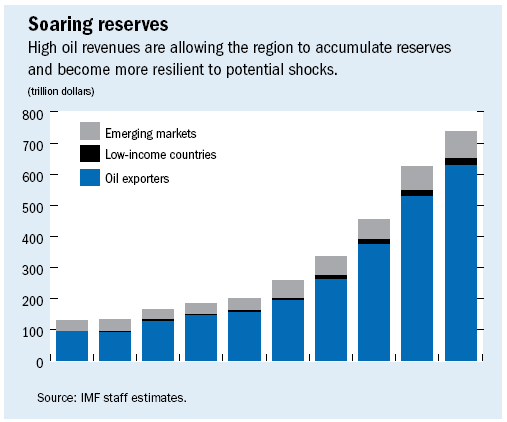
Typical street scene in Santa Ana, El Salvador. (Photo: iStock)
IMF Survey: Sound Policies Behind Strong Growth
June 7, 2007
- Oil-producing countries should invest and set aside resources for future
- Improving distribution of income would reduce poverty and sustain growth
- Further broadening and deepening of financial markets would benefit region
All country groupings—oil exporters, emerging markets, and low-income countries—in the Middle East and Central Asia region have been performing well, an IMF press briefing heard May 14.

Market vendor in al-Arish, Egypt—one of the fast-growing emerging markets in Middle East, Central Asia region (photo: Marwan Naamani/AFP)
Middle East and Central Asia Outlook
The briefing, by Mohsin Khan, Director of the IMF department responsible for the region, marked the release of the May 2007 Regional Economic Outlook: Middle East and Central Asia. Robust global growth, a favorable international financial environment, continued high prices for oil and other commodities, and sound policies in many countries are underpinning this strong growth. Real GDP growth is expected to remain strong at more than 6 percent on average, with double-digit growth projected in the Caucasus and Central Asian countries (see table).

However, strong foreign exchange inflows—export receipts, foreign direct investment, and remittances—and rapid demand growth, combined with accommodative monetary policies, are fueling inflation, which is expected to increase to 9 percent this year from 7½ percent last year. The report says the rise is particularly notable in some oil-exporting countries, where higher inflation is beginning to translate into more appreciated real effective exchange rates, as would be expected in response to increased oil prices.
Oil factor
The Middle East and Central Asia countries have benefited more from the high price of oil than other regions because they hold almost three-fourths of the world's proven oil reserves and account for one-third of world oil production. Rising prices of other commodities have also benefited the region, which accounts for one-fifth of the world's gas production and boasts the largest aluminum smelter site in the world (United Arab Emirates).
In addition, the region is well endowed with cotton (Uzbekistan), copper (Armenia and Georgia), and uranium (Armenia and Uzbekistan). In 2006, it had a combined GDP of $1.8 trillion, with oil contributing one-third of that amount. At the end of 2006, its international reserves amounted to $625 billion, compared with China's $1.1 trillion and Russia's $285 billion.
With oil prices expected to average about $61 a barrel in 2007, compared with more than $64 a barrel last year, export receipts and government revenue from oil and gas will be lower this year. As a result, the external current account surplus will decline, but only one-fourth of the projected fall will be because of lower oil prices.
The remaining fall in the current account surplus reflects sharply rising imports as social and infrastructure investment plans are implemented. As external and fiscal positions are expected to remain strong, the oil-exporting countries in the region should be able to undertake their investment plans while continuing to set aside resources for the future.
Sustaining strong growth
But there are risks to the generally very positive outlook, Khan continued. "Potentially adverse global developments include the possibility of slower world growth, perhaps triggered by a sharper-than-expected slowdown in the United States or a sustained rise in financial market volatility," he said. At the regional level, Khan noted that escalating conflicts are a perennial threat.
On a positive note, as the countries in this region increase their international reserves (see chart) and reduce their debt, they are becoming more resilient to potential shocks. Khan said that the region's key policy challenge is to sustain or even accelerate growth to make significant inroads into reducing poverty and unemployment. "
Strong growth has not yet generated sufficient jobs for the rapidly expanding labor force, and poverty rates have not yet declined much, even in the rapidly growing low-income countries," he said. To reduce poverty, the region's governments should improve the distribution of income, which would also generate support for reform and help sustain the growth momentum.

Oil revenue management
Within the region, different groups of countries face somewhat different challenges.
Oil-exporting countries. The region's 14 oil exporters can expect GDP growth to remain slightly higher than 6 percent in 2007 despite lower projections for oil prices. For these countries, sound management of oil revenue will be a top priority.
In most countries, investment spending has picked up: investments to increase oil production and refining capacity will alleviate the tightness in the supply of refined petroleum products, and investments in both oil and non-oil sectors will increase imports, thereby contributing to the orderly resolution of global imbalances.
In some countries, supply bottlenecks and signs of overheating have emerged. In these cases, the authorities will need to take account of their economies' absorptive capacity in judging the speed at which large projects should be implemented, in order to ensure that high growth can be sustained in a stable macroeconomic environment.
Reforms required
Another issue for some oil exporters is the need to diversify their economies in the face of the anticipated declines in oil production. This calls for an increased role for the private sector. Various reforms will be required to facilitate this process, including improving the business environment, lifting price controls, developing their financial sectors, further opening key activities to private and foreign participation, and strengthening their overall legal and regulatory frameworks.
Emerging market countries. Five of the six countries in this group—Egypt, Jordan, Morocco, Pakistan, and Tunisia—are likely to continue to grow vigorously in 2007, whereas Lebanon can expect subdued growth because of ongoing political tensions following its conflict with Israel last summer. Inflation is not expected to increase, but large fiscal deficits are keeping government debt high in several countries.
In all countries in the subgroup, fiscal consolidation will be the key to sustaining a stable macroeconomic environment, and governments will need to adopt fiscal reforms to broaden the tax base, reduce exemptions, improve tax administration, and reduce subsidies.
Foreign-financed investments
Low-income countries. Growth in these countries should continue to be strong, particularly in Afghanistan (because of a rebound in agriculture and activity in construction and services), Armenia (because of buoyancy in construction and services and recovery in exports), Georgia (from strong growth in services and manufacturing), and Sudan (because of increased oil production). And strong external demand should allow Uzbekistan to perform well.
The governments of low-income countries face the challenge of managing the macroeconomic impact of large-scale foreign-financed investments. Because of their progress in cementing macroeconomic stability, reducing debt, and improving policies in general, these countries are attracting increased financing, which, in turn, will allow them to invest more in infrastructure and human capital, reduce unemployment, and enhance prospects for higher potential output.
However, these governments must also balance these benefits against the need to ensure medium-term debt sustainability. To mitigate risks, they must manage debt well, keep spending in line with their economies' absorptive capacity, and improve financial management to avoid waste.
All countries in the region would also benefit from a further broadening and deepening of the region's financial markets. In particular, there is a need to strengthen banking system soundness, monitor market risks, and increase the depth and liquidity of capital markets to reduce asset market volatility and use the region's large savings efficiently.


